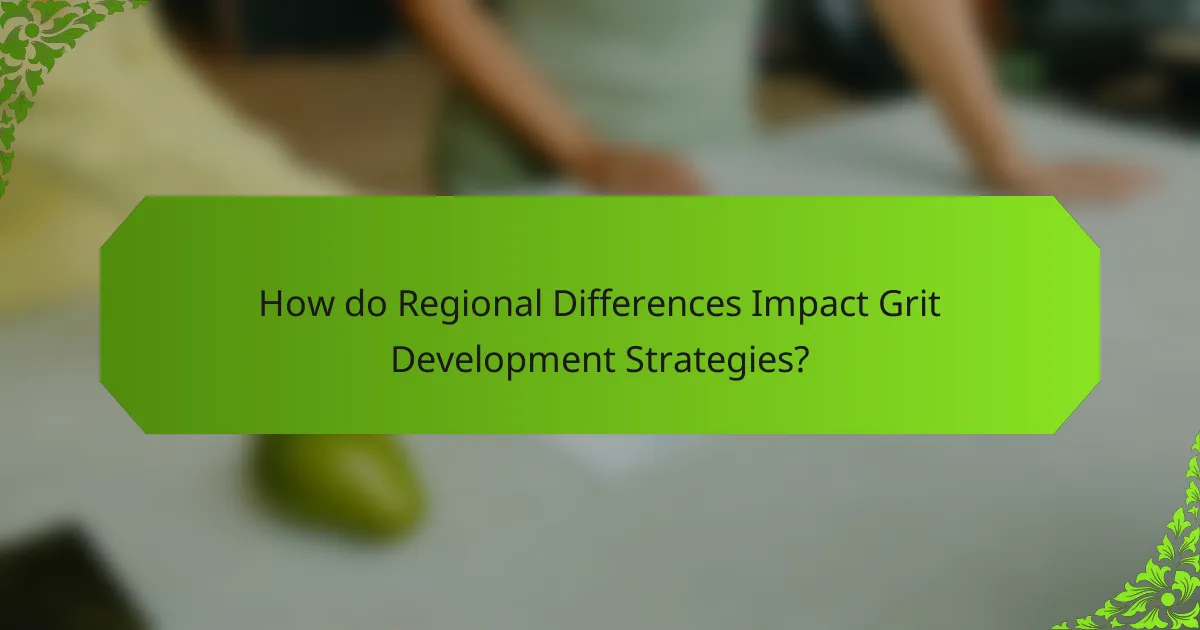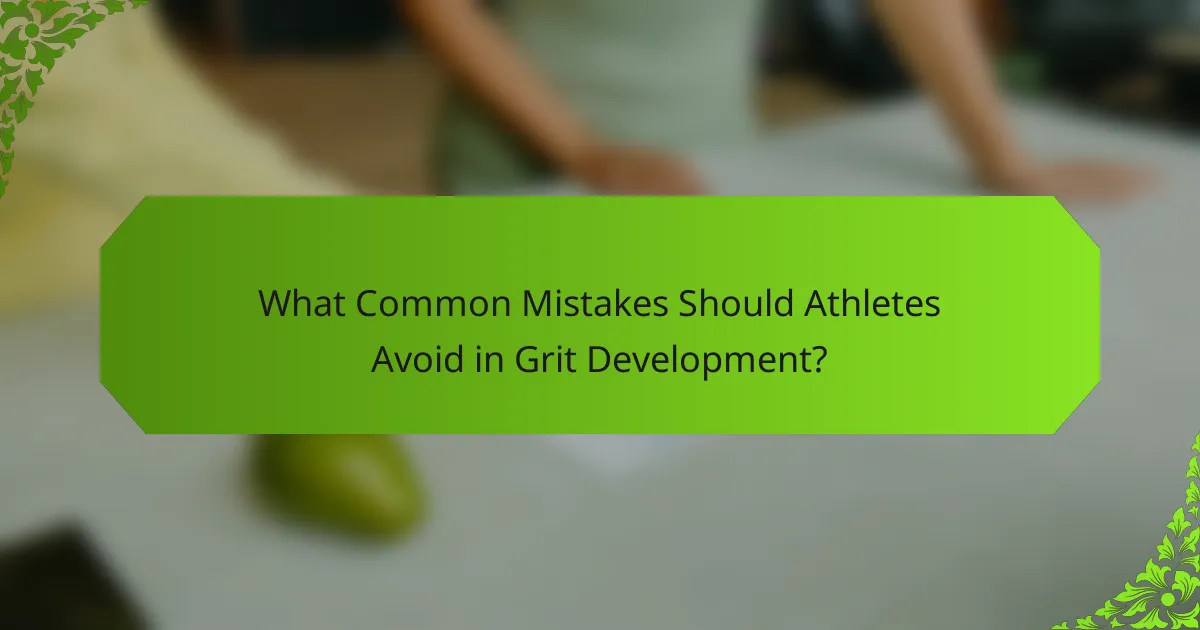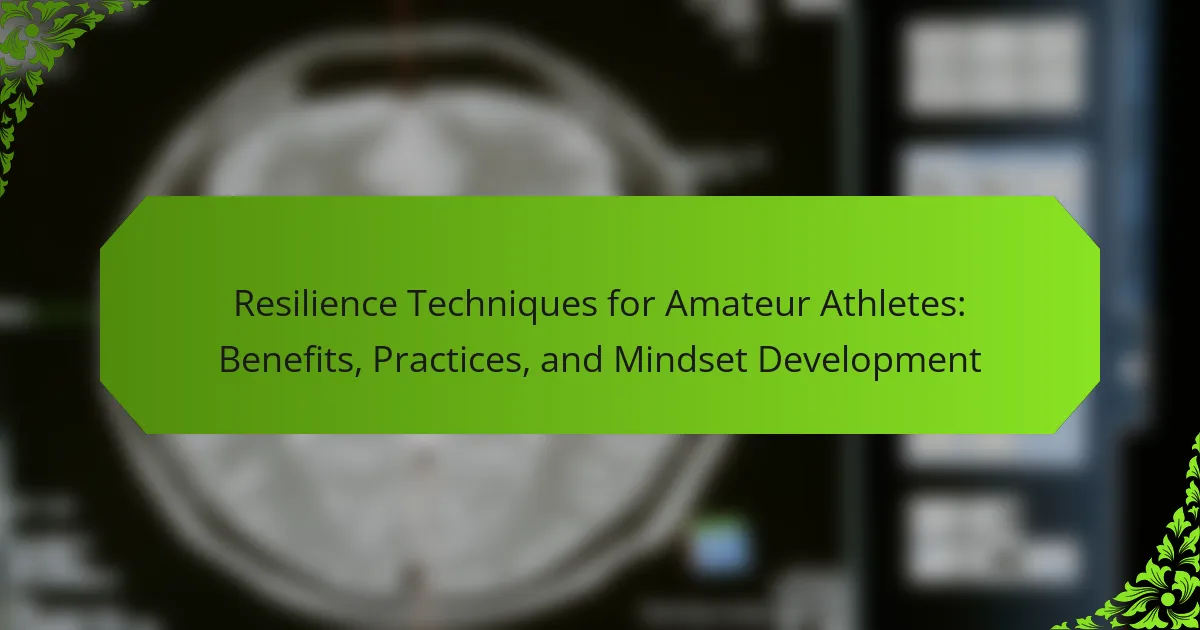Building grit is crucial for amateur athletes to enhance resilience and overcome setbacks. This article explores strategies like embracing challenges, setting specific goals, and reflecting on progress. It also highlights the importance of cultivating a support network and practicing mindfulness. Understanding regional influences on grit development can further tailor approaches for effective mental toughness training.

What is Grit and Why is it Important for Amateur Athletes?
Grit is essential for amateur athletes as it fosters resilience and perseverance in the face of challenges. Developing grit involves strategies such as setting specific goals, maintaining a growth mindset, and embracing failures as learning opportunities. These approaches help athletes build mental toughness, crucial for overcoming setbacks. Research shows that athletes with higher grit levels tend to achieve greater success and maintain motivation over time. By cultivating grit, amateur athletes enhance their performance and develop skills that extend beyond sports.
How does Grit impact athletic performance?
Grit significantly enhances athletic performance by fostering resilience and perseverance. Athletes with high grit are more likely to push through challenges, maintain focus, and achieve long-term goals. Research indicates that grit correlates with success in sports, as it encourages consistent effort and dedication. Developing grit through strategies such as goal setting, self-reflection, and embracing failure can lead to improved mental toughness and overall performance.
What are the psychological benefits of developing Grit?
Developing grit enhances resilience, self-discipline, and emotional regulation in amateur athletes. These psychological benefits lead to improved performance and a greater ability to overcome setbacks. Athletes with grit are more likely to persist in challenging situations, fostering a growth mindset. Research indicates that grit correlates with long-term success and satisfaction in sports. This mental toughness empowers athletes to navigate stress and maintain motivation, ultimately benefiting their overall athletic journey.

What are the Universal Strategies for Developing Grit?
To develop grit, amateur athletes should focus on resilience, goal-setting, and self-reflection. These strategies help them overcome setbacks and enhance mental toughness.
1. Embrace Challenges: Facing difficulties builds resilience. Athletes should seek out challenging situations to strengthen their grit.
2. Set Specific Goals: Clear, achievable goals provide direction and motivation. Breaking larger goals into smaller tasks can improve focus.
3. Reflect on Progress: Regular self-reflection allows athletes to assess their growth and identify areas for improvement. This practice fosters a growth mindset.
4. Cultivate a Support Network: Surrounding themselves with supportive peers and mentors can reinforce commitment and provide encouragement during tough times.
How can goal setting enhance Grit?
Goal setting significantly enhances grit by providing clear direction and motivation for amateur athletes. Establishing specific, measurable goals fosters resilience and determination, essential for overcoming setbacks. Athletes learn to focus on incremental progress, reinforcing their mental toughness. By tracking achievements, they cultivate a growth mindset, essential for sustained effort and persistence.
What techniques can be used for effective goal setting?
Effective goal setting for amateur athletes involves techniques like SMART goals, visualization, and progress tracking. These strategies enhance grit and mental toughness, helping athletes overcome setbacks.
SMART goals ensure objectives are Specific, Measurable, Achievable, Relevant, and Time-bound. Visualization techniques improve focus and motivation by mentally rehearsing success. Progress tracking provides feedback, reinforcing commitment and resilience.
Incorporating these methods fosters a growth mindset, essential for developing grit. Setting realistic short-term goals, alongside long-term aspirations, maintains motivation and encourages persistence through challenges.
In what ways does self-discipline contribute to Grit?
Self-discipline significantly enhances grit by fostering persistence and resilience in athletes. It enables them to stay focused on long-term goals despite setbacks. Self-discipline encourages consistent practice and commitment, essential for developing mental toughness. This foundational trait supports athletes in overcoming challenges, ultimately leading to greater success in their pursuits.
How does resilience play a role in building Grit?
Resilience is crucial for developing grit as it enables athletes to recover from failures and persist through challenges. Resilient athletes view setbacks as opportunities for growth, reinforcing their determination. This mindset fosters mental toughness, a key attribute for sustained performance. Studies show that resilience correlates with higher achievement levels in sports, highlighting its role in grit development.

What Unique Attributes Distinguish Grit Development Strategies?
Grit development strategies for amateur athletes are distinguished by their focus on resilience, goal-setting, and adaptability. These strategies integrate mental toughness training, emphasizing perseverance through challenges. Unique attributes include personalized feedback mechanisms that enhance self-awareness and foster a growth mindset. Additionally, the incorporation of visualization techniques can differentiate these strategies, allowing athletes to mentally rehearse overcoming setbacks.
How can personalized training plans foster Grit?
Personalized training plans can significantly enhance grit by providing tailored challenges that match an athlete’s individual capabilities. These plans foster resilience through structured goal-setting, which encourages perseverance in the face of setbacks.
Athletes experience incremental progress, reinforcing their mental toughness. For instance, specific feedback and adjustments in training help individuals confront difficulties effectively. This personalized approach cultivates a growth mindset, essential for developing grit over time.
Additionally, tracking progress through personalized metrics allows athletes to visualize their improvement, further motivating them to push through obstacles. By focusing on personal achievements, athletes build confidence and a stronger sense of commitment to their goals.
What role do mentorship and coaching play in Grit development?
Mentorship and coaching play a crucial role in developing grit among amateur athletes by providing guidance and support through challenges. These relationships foster resilience and a growth mindset, enabling athletes to learn from setbacks. Coaches can offer personalized strategies that enhance mental toughness, while mentors share experiences that inspire perseverance. Together, they help athletes navigate obstacles, reinforcing the understanding that failure is a stepping stone to success.

What are the Rare Attributes of Successful Grit Development?
Successful grit development in amateur athletes often includes rare attributes like adaptability, emotional regulation, and intrinsic motivation. These traits enable athletes to navigate challenges uniquely and persist despite obstacles. For instance, adaptability allows for quick adjustments to training regimens based on performance feedback. Emotional regulation helps athletes manage stress, while intrinsic motivation fosters a deeper commitment to long-term goals. These rare attributes differentiate successful grit development from mere perseverance, enhancing overall mental toughness.
How can overcoming unique challenges enhance Grit?
Overcoming unique challenges enhances grit by fostering resilience and adaptability. Amateur athletes face setbacks that test their mental toughness. Each challenge provides an opportunity to develop problem-solving skills and perseverance. As a result, these experiences build confidence, reinforcing the athlete’s commitment to their goals. Embracing difficulties transforms them into stepping stones for personal growth.
What uncommon methods have proven effective in building Grit?
Uncommon methods that have proven effective in building grit include embracing discomfort, practicing self-reflection, and utilizing visualization techniques. Embracing discomfort involves intentionally facing challenges that push limits, fostering resilience. Self-reflection helps athletes analyze setbacks and learn from them, enhancing mental toughness. Visualization techniques allow athletes to mentally rehearse overcoming obstacles, reinforcing their determination and focus.

How do Regional Differences Impact Grit Development Strategies?
Regional differences significantly influence grit development strategies for amateur athletes. Cultural attitudes towards perseverance and failure shape how athletes respond to setbacks.
For instance, in collectivist societies, community support may enhance resilience, while individualistic cultures may promote self-reliance in overcoming challenges. Regional access to resources, such as coaching and training facilities, also impacts the strategies employed.
Additionally, varying educational systems can foster different approaches to mental toughness. Some regions emphasize competitive sports from an early age, instilling grit through structured challenges. Others may focus on holistic development, encouraging athletes to embrace failures as learning opportunities.
Understanding these regional nuances allows coaches and mentors to tailor grit development strategies effectively, ensuring they resonate with the athletes’ backgrounds and experiences.
What cultural factors influence Grit in amateur sports?
Cultural factors significantly influence grit in amateur sports by shaping athletes’ mindsets and resilience. Community values, family support, and societal expectations play critical roles in developing mental toughness. For instance, cultures that emphasize perseverance often encourage athletes to embrace challenges and setbacks as growth opportunities. Additionally, access to resources and mentorship within a cultural context can enhance grit by providing guidance and motivation. Ultimately, understanding these cultural influences can help coaches and athletes cultivate a stronger sense of grit.
How can local sports communities support Grit development?
Local sports communities can significantly enhance grit development in amateur athletes by fostering resilience, providing mentorship, and creating supportive environments. These communities offer opportunities for athletes to face challenges together, which builds mental toughness.
Structured training sessions can include goal-setting and reflection on setbacks, encouraging athletes to learn from failures. Additionally, peer support networks within these communities can motivate individuals to persist through adversity.
Engaging in local competitions allows athletes to experience pressure and learn to cope with it, further enhancing their grit. Overall, the collective effort of local sports communities plays a vital role in nurturing perseverance and resilience in athletes.

What Common Mistakes Should Athletes Avoid in Grit Development?
Athletes should avoid common mistakes like neglecting mental training, setting unrealistic goals, and failing to learn from setbacks. Focus on consistent practice, realistic expectations, and resilience to build grit effectively. Prioritize mental toughness alongside physical training for comprehensive development.
How can athletes identify and rectify these mistakes?
Athletes can identify and rectify mistakes by conducting regular self-assessments and seeking feedback from coaches. Focus on specific areas for improvement, such as technique or strategy. Develop a growth mindset to embrace setbacks as learning opportunities. Establish a routine for reflection after training sessions and competitions to pinpoint errors and adjust approaches.

What Best Practices Can Help Athletes Build Grit Effectively?
Amateur athletes can build grit effectively by adopting specific strategies that focus on resilience and mental toughness. Setting realistic goals helps athletes maintain motivation during setbacks. Embracing challenges fosters a growth mindset, allowing athletes to view obstacles as opportunities for improvement. Regularly reflecting on experiences enhances self-awareness, enabling athletes to learn from failures. Seeking support from coaches and peers creates a strong support network, reinforcing perseverance. Finally, practicing mindfulness techniques can improve focus and emotional regulation, essential for overcoming adversity.
What daily habits promote mental toughness in athletes?
Daily habits that promote mental toughness in athletes include setting clear goals, practicing resilience through challenges, and maintaining a consistent training routine. Engaging in mindfulness practices enhances focus, while regular self-reflection fosters growth. Building a support network also contributes to overcoming setbacks.
How can athletes measure their Grit development progress?
Athletes can measure their grit development progress through self-assessments, performance metrics, and feedback. Self-assessments can include questionnaires focusing on resilience and perseverance. Performance metrics involve tracking improvements in training consistency and competition results. Feedback from coaches and peers provides insights into mental toughness and adaptability during challenges.



